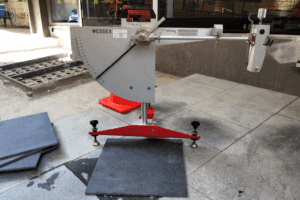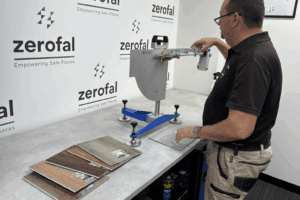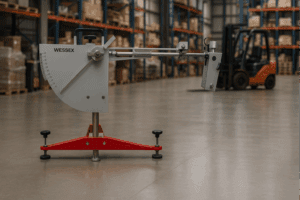Can You Fail a Slip Test?
Yes- Here's why
Yes, surfaces can fail slip resistance testing—and it’s more common than you think. Whether tested in a lab (AS 4586-2013) or onsite (AS 4663-2013), failed results can trigger product relabelling, remediation, or liability exposure. This article explains why surfaces fail, what happens next, and how to avoid it.
Slip resistance testing isn’t just a formality—it’s a compliance check. And yes, surfaces do fail. More often than you’d think.
Whether it’s a brand-new tile being tested in the lab (AS 4586-2013) or a site floor being checked for ongoing safety (AS 4663-2013), test failures are a real and frequent outcome. Understanding why they happen—and what to do about them—can protect your project, your people, and your liability position.
How a Slip Test Works
Under AS 4586-2013, new pedestrian surface materials are tested in a controlled lab environment using the wet pendulum test or dry floor friction test. Results are classified on a scale from P0 to P5 (wet) or D0/D1 (dry). Manufacturers use these results to certify surfaces as safe for installation.
Under AS 4663-2013, existing in-use surfaces are tested onsite. This includes areas that have been sealed, coated, worn down, or simply exposed to weather and cleaning. There’s no “pass” or “fail” label in AS 4663-2013—but your results must align with risk guidelines like HB198 Table 3B or NCC Deemed-to-Satisfy Provisions. If they don’t, you’ve failed in practical terms—even if the report doesn’t say so.
Why Surfaces Fail
Common reasons include:
- Polish or coating has changed surface friction
A P4 tile can easily become P2 after sealant is applied—or vice versa. - Incorrect flooring for the location
A floor may be P3-rated, but that’s not enough for a wet entry ramp or commercial kitchen. - Cleaning residues or contamination
Waxes, detergents, and grime buildup all reduce slip resistance. Even clean-looking floors can fail. - Surface wear or inconsistent finish
Textured tiles may wear smoother in high-traffic lanes. We often find variation across the same product line. - Improper sample preparation
Lab tests are only valid if the sample reflects how the product is sold—coated, sealed, or raw. Supplying the wrong version can lead to reclassification.
What Happens if You Fail?
It depends on the context:
- Lab test failure (AS 4586-2013):
You may need to modify the product, apply a compliant coating, or relabel the classification. - Site test failure (AS 4663-2013):
Corrective action is required: cleaning, recoating, remedial works, restricting use, or resurfacing. Failing to respond can expose the facility to liability and insurance risk.
How to Avoid Failure
- Test pre-installation: Certify new surfaces under AS 4586-2013 before sign-off.
- Test post-installation if treatment is added: Many coatings change slip performance.
- Test periodically under AS 4663-2013: Especially in high-traffic or high-risk areas suitable to your risk profile.
- Use an independent, NATA- certified tester: Not a contractor with a conflict of interest e.g. they apply a coating and test their own materials.
Don’t Wait for a Fall
Failing a slip test isn’t the end of the world—but failing to test at all could be.
Zerofal provides certified, slip resistance testing for both new and existing surfaces. We’ll help you interpret your results, identify issues, and find a compliant path forward.
Talk to us today about your surface, your risk, and your next step.
Need Help Interpreting Your Slip Test?
Whether your surface failed or you’re unsure what the result means, we can help.
Zerofal provides certified testing to AS 4586-2013 (lab) and AS 4663-2013 (onsite) and works with contractors, managers, and certifiers to find compliant next steps.
Explore more

Colour, Grit and Surface Finish: How Subtle Differences Change Slip Ratings (AS 4586:2013)
Colour, grit and finish change slip resistance. Learn why P-ratings vary across tile ranges and coatings

Why One Slip Test Isn’t Enough for Product Lines (AS 4586:2013)
Slip resistance varies across colours and finishes. Learn why one AS 4586 test cannot certify an entire product line.

Industrial Slip Resistance: Dust, Boots & Coating Drift (AS 4663:2013)
: Industrial floors change fast. Learn how dust, coatings and machinery reduce slip resistance and why AS 4663 onsite testing is essential.
Stay Ahead of Safety Standards
Join the Zerofal newsletter for actionable insights on slip testing, compliance updates, and smart prevention strategies. No spam – just practical safety advice.
